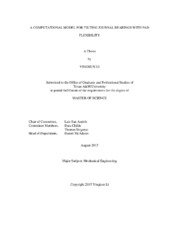| dc.description.abstract | Tilting pad journal bearings (TPJBs) supporting rotors for high performance turbomachinery have undergone steady design improvements to satisfy more stringent operating conditions that include large specific loads due to smaller footprints, and high surface speeds that produce larger drag power losses and lubricant temperature rise. Simultaneously, predictive models continuously evolve to include minute details on bearing geometry, pads and pivots’ configurations, oil delivery systems, etc.
This thesis introduces a fluid film flow model including both pad and pivot flexibility to predict the static and dynamic force performance of typical TPJBs. This performance encompasses journal eccentricity, drag power loss, lubricant temperature rise, fluid film thickness, fluid film pressure, bearing complex stiffnesses, static stiffnesses, damping coefficients and virtual mass coefficients. A finite element (FE) pad structural model (with/without the Babbitt layer) is coupled to a thin film flow model to determine the mechanical deformation of the pad upper surface.
Recently, Gaines and Childs conducted experiments with three TPJB sets, each having three pads, over a range of load and rotational speed conditions. To quantify the effect of pad flexibility on the bearings’ dynamic performance, the pad thickness varies from thin to thick, t=8.5 mm, 10 mm and 11.5mm. The test data shows that pad flexibility reduces the journal eccentricity and the dynamic force coefficients. The current model with both pad and pivot flexibility delivers predictions correlating favorably with the test data, in particular the bearing stiffnesses, yet it overestimates the bearing damping coefficients.
Predictions for bearing models available in the archival literature show that the maximum pad surface deformation occurs on the loaded pad at both its leading and trailing edges; i.e. under mechanical pressure a pad opens. The deformation at the pad mid-plane (Z=0) is slightly larger than that at the pad side edges (Z=±1/2 L). Contrary to the effect of pivot flexibility that leads to an increase in journal eccentricity, pad flexibility tends to reduce the journal eccentricity, similar as in tests reported by Gaines. A soft pad (elastic) decreases significantly the bearing stiffnesses and the damping coefficients by up to 20%.
A parametric study follows to quantify the influence of pad thickness on the rotordynamic force coefficients of two sample TPJBs: one with three pads of increasing preload, ( p r =0, 0.25 and 0.5), and another one with four pads of null preload ( p r =0). The bearing pads are either rigid or flexible by varying their thickness. For design considerations, dimensionless static and dynamic characteristics of the bearings are presented versus the Sommerfeld number (S).
An appendix introduces a one-dimensional beam equation to approximate the pad deformation accounting for the Babbitt layer. Based on this equation, a dimensionless pad flexibility parameter is defined. Pad flexibility shows a more pronounced effect on the journal eccentricity and the force coefficients of a TPJB with null pad preload than for bearings with large pad preloads (0.25 and 0.5), in particular for operation with a small load or at a high surface speed (S>0.8). With the same pad preload, pad flexibility affects more the dynamic force coefficients for a load on pad (LOP) bearing than those for a load between pad (LBP) bearing. | en |


